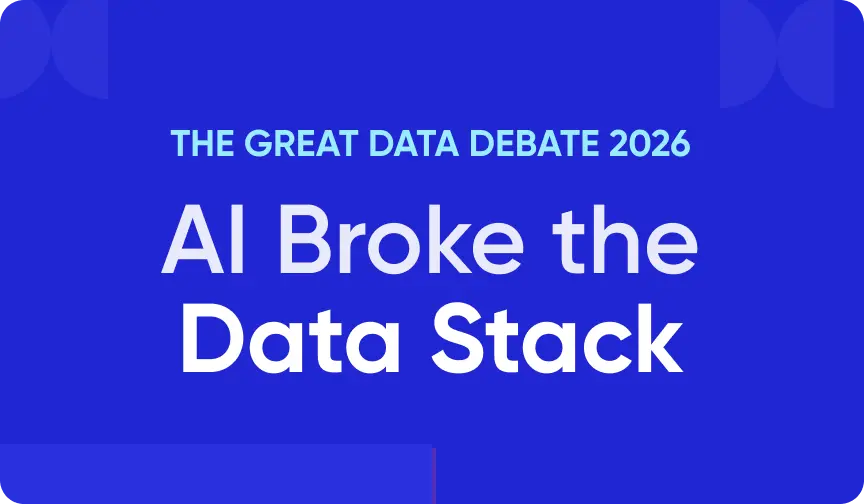Microsoft Fabric Copilot: AI-Driven Insights & Workflow Automation

Share this article
Microsoft Fabric Copilot is a cutting-edge AI assistant designed to simplify data workflows and enhance analytics within the Microsoft ecosystem.
See How Atlan Simplifies Data Governance – Start Product Tour
By leveraging advanced natural language processing and machine learning, it automates routine tasks, improves data integration, and accelerates decision-making.
Seamlessly integrated with tools like Power BI and Azure OpenAI, Copilot delivers real-time insights and empowers teams with predictive analytics.
Its user-friendly interface supports businesses in optimizing operations, fostering collaboration, and achieving scalability.
In today’s data-driven world, businesses need intelligent, self-service analytics to derive value from their data. That’s where Microsoft Fabric, a unified platform for data analytics, and Copilot, an AI assistant, can help.
In this article, we’ll explore the capabilities of Copilot and how it enhances each experience within Microsoft Fabric. We’ll discuss their origins, capabilities, limitations, and real-world applications.
Table of contents
Permalink to “Table of contents”- Copilot: What is it?
- Copilot in the Microsoft ecosystem: Origins, Azure Open AI architecture, and the plugin ecosystem
- Copilot in Microsoft Fabric: Capabilities
- Copilot in each Microsoft Fabric experience: What would that look like?
- Copilot in Microsoft Fabric: Real-world applications
- Copilot in Microsoft Fabric: Limitations
- Copilot for workflow automation via Microsoft Fabric (Power BI) and Power Automate: A step-by-step guide
- How organizations making the most out of their data using Atlan
- Summary
- FAQs about Microsoft Fabric Copilot
- Microsoft Fabric Copilot: Related reads
Copilot: What is it?
Permalink to “Copilot: What is it?”Copilot is an AI assistant that can understand natural language inputs and produce reports with actionable insights. It can make data analytics accessible and inclusive by empowering all data practitioners — even those without a technical background.
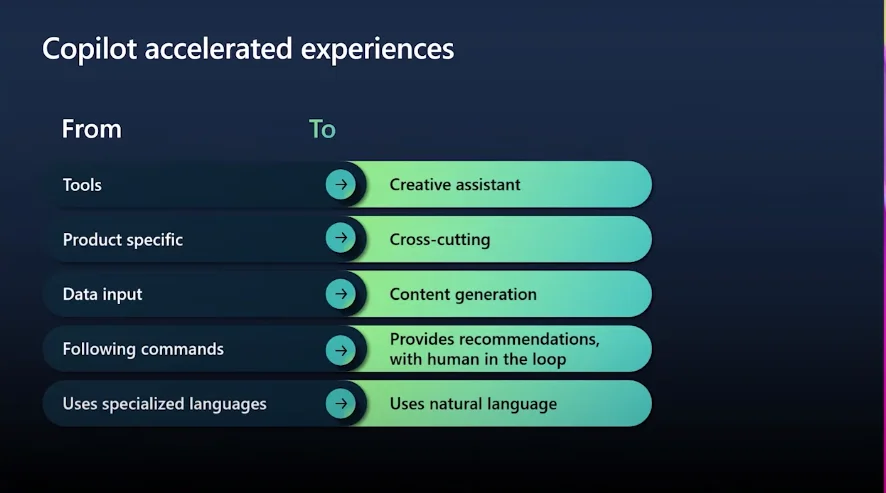
The experiences accelerated by Microsoft Fabric Copilot - Source: Youtube.
The need for Copilot in Microsoft Fabric
Permalink to “The need for Copilot in Microsoft Fabric”Navigating today’s ever-changing digital universe, organizations encounter a relentless flood of data — a hidden trove of potential insights. Yet, unlocking this potential is far from simple; data is stored in disconnected (siloed) compartments, and it appears in a variety of formats from numerous sources.
Moreover, data synchronization issues arise from siloed data and lead to integration expenses. Subpar data quality then compromises the effectiveness of AI models, and outdated reports lead to inaccurate interpretations of data, hindering innovation.
To address this issue, Microsoft Fabric’s design mirrors an “information metropolis” with distinct districts, each attending to a unique data requirement. Copilot acts as the AI-powered tour guide for this metropolis.
Microsoft envisions a copilot for each of its products — Power BI, Microsoft Fabric, Windows, etc. The goal is to infuse each layer of Fabric (and other products in the Microsoft ecosystem) with generative AI to help all data practitioners find insights in their data.
Before proceeding further with Copilot in Microsoft Fabric, it’s important to understand this vision for Copilot and subsequently, plugins that integrate them.
Copilot in the Microsoft ecosystem: Origins, Azure Open AI architecture, and the plugin ecosystem
Permalink to “Copilot in the Microsoft ecosystem: Origins, Azure Open AI architecture, and the plugin ecosystem”The origins of Microsoft’s Copilot
Permalink to “The origins of Microsoft’s Copilot”Microsoft came up with the idea of a “copilot” through GitHub Copilot, an AI assistant that helps programmers write code.
In a broader sense, Microsoft defines a copilot as “an application that uses modern AI and large language models to assist you with a complex cognitive task – from writing a sales pitch or catching up on a missed meeting to generating images for a presentation or planning a themed dinner party.”
Microsoft later started incorporating this idea into its main products and services, such as Microsoft 365 Copilot,Dynamics 365 Copilot, and more. The most recent Copilot integrations include products like Power BI, Power Pages, Microsoft Fabric, and Windows 11.
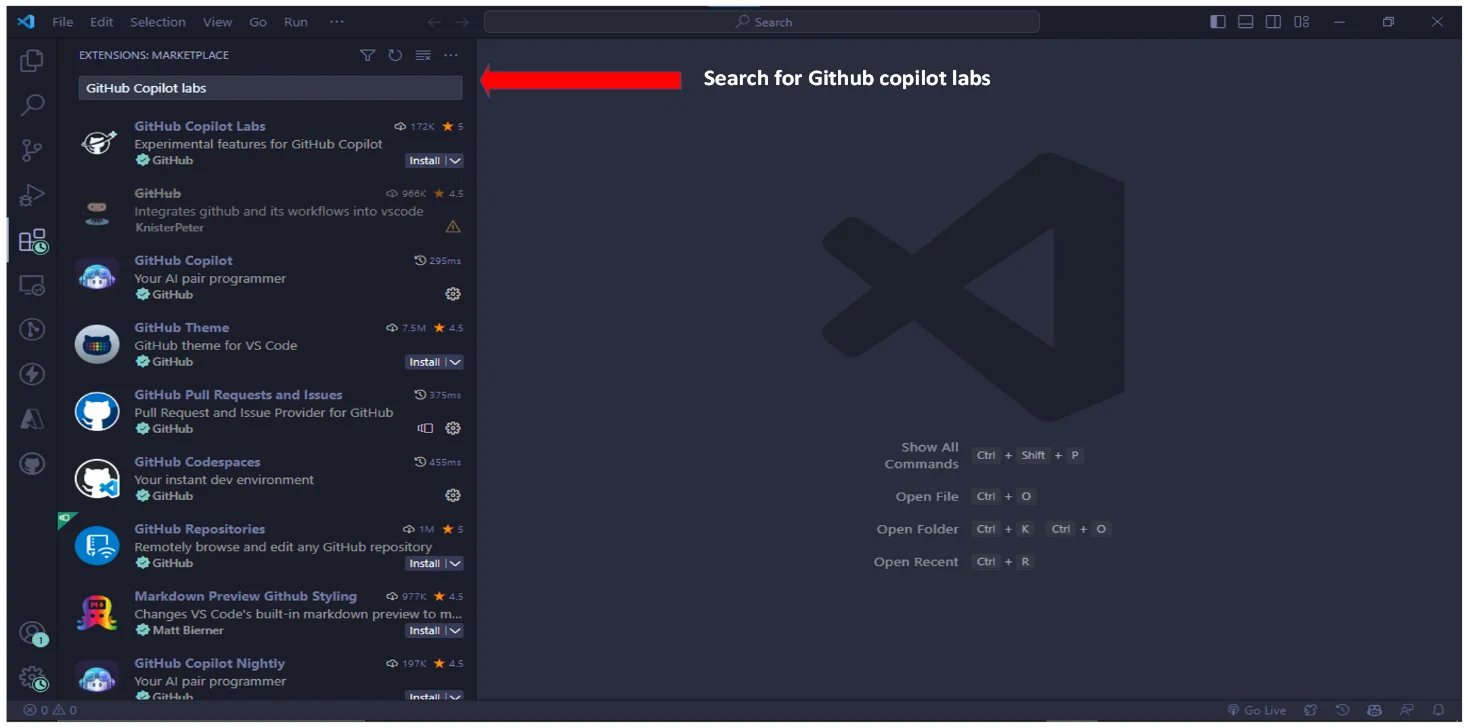
GitHub Copilot Labs - Source: Microsoft.
Note: We’ll be referring to generic LLM applications within Microsoft as “copilots”. For the generative AI experience within each layer of Microsoft Fabric, we’ll be using the term “Copilot”.
What powers the copilots within Microsoft’s ecosystem?
Permalink to “What powers the copilots within Microsoft’s ecosystem?”The Azure OpenAI Service encompasses an array of AI models and generative AI utilities. Included in this portfolio is the fourth-generation generative AI model, GPT-4, that fuels a number of applications, most notably GitHub Copilot.
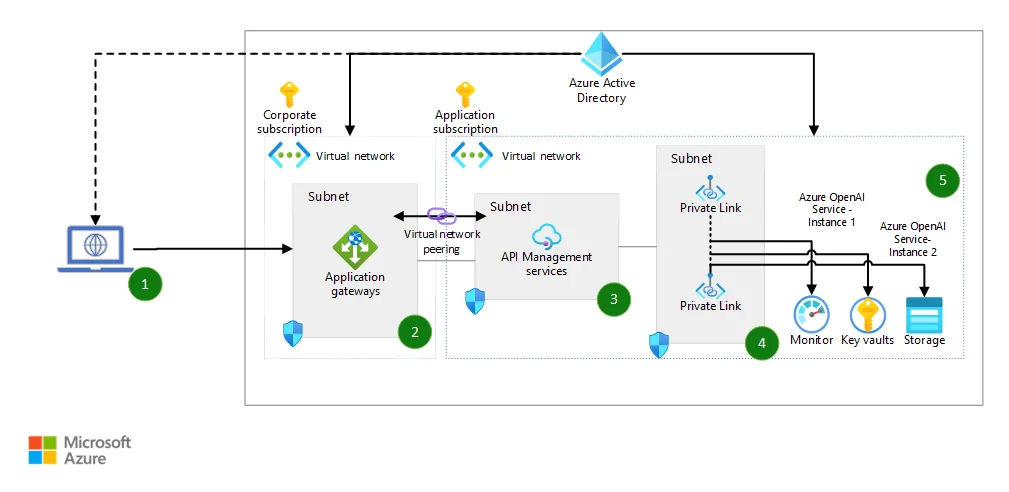
Azure Open AI architecture - Source: Microsoft.
The copilots use Azure OpenAI Service to serve their purpose. Microsoft intends to go further than building an ecosystem of copilots with plugins.
Let’s explore these plugins further.
What are copilot plugins?
Permalink to “What are copilot plugins?”Microsoft defines plugins as tools that make copilots more useful by allowing them to interact with other software and services. The goal is to help developers build their own copilots and next-generation AI applications.
With plugins, your copilot can access live data from external systems, incorporate business-specific data from a variety of sources, execute unique computations, and perform tasks based on user input. This helps in tailoring the AI system to your specific business needs.
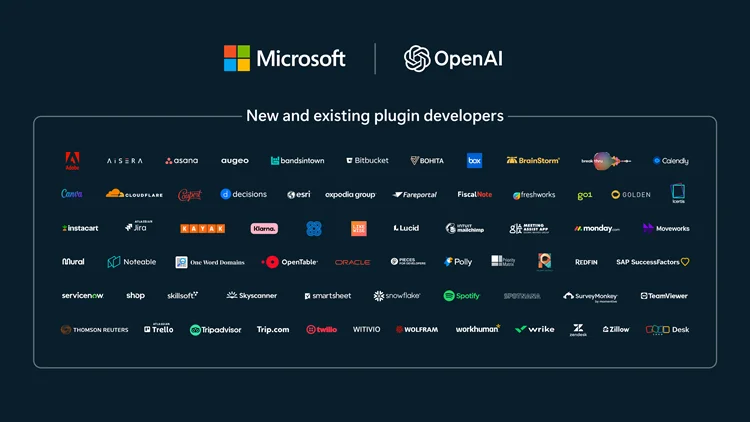
Satya Nadella illustrates Microsoft’s new and existing plugin developers at Microsoft Build 2023 - Source: Microsoft.
Open plugin standard
Microsoft follows an open plugin standard, making it easy for different systems to work together and encourages a diverse plugin environment. Thanks to the open standard, developers can use a single platform to build plugins that are compatible with both business and personal interfaces, including ChatGPT, Bing, Dynamics 365 Copilot, Microsoft 365 Copilot, and Windows Copilot.
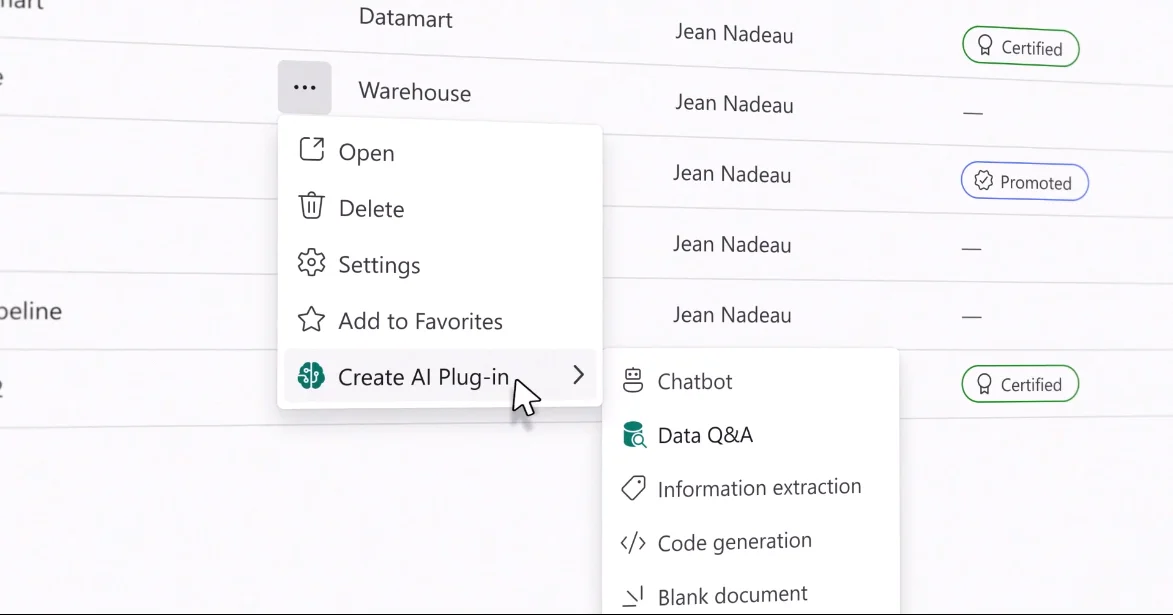
Create your own plugins in Microsoft Fabric Copilot - Source: Microsoft.
Example
For instance, a developer can create a plugin that links Copilot to a private database of legal documents in Microsoft Fabric. This would allow Copilot to access and search these documents for information on past legal cases.
Another plugin could connect Copilot to a business’s travel booking system, letting it arrange trips that comply with the company’s policies.
Guidelines for creating and using plugins
To aid developers in making these plugins, Microsoft has provided a thorough set of guidelines and development tools. These include resources like detailed instructions on how to use the API, best practices for development, and a supportive community where developers can ask questions and share knowledge.
Azure Open AI and Microsoft Fabric Copilot
Permalink to “Azure Open AI and Microsoft Fabric Copilot”Copilot, integrated into Microsoft Fabric, uses Azure OpenAI Service to make jobs easier. Microsoft highlights that developers can use coding and language models for a variety of use cases, such as writing assistance, code generation, and reasoning over data.
This is true for parts of Fabric like Data Factory, Data Engineering Workloads, Synapse Analytics, Data Activator, and Power BI.
According to Microsoft:
“With Copilot in Microsoft Fabric in every data experience, users can use conversational language to create dataflows and data pipelines, generate code and entire functions, build machine learning models, or visualize results.”
Copilot in Microsoft Fabric: Capabilities
Permalink to “Copilot in Microsoft Fabric: Capabilities”The key strengths of Copilot in Microsoft Fabric involve AI-assisted help, machine learning and personalization, and understanding human language.
AI-assisted support
Permalink to “AI-assisted support”Fabric Copilot lends a hand in perfecting your project management methods. As someone who works with data, you can use this AI tool to improve the visibility of your projects and make teamwork more efficient.
When you ask for a project update, Fabric Copilot dives into the project management software of your company, extracts data, and studies it to generate detailed reports. These reports give you an instant picture of where your tasks stand, such as completed and ongoing tasks, who’s responsible for what, and expected timelines.
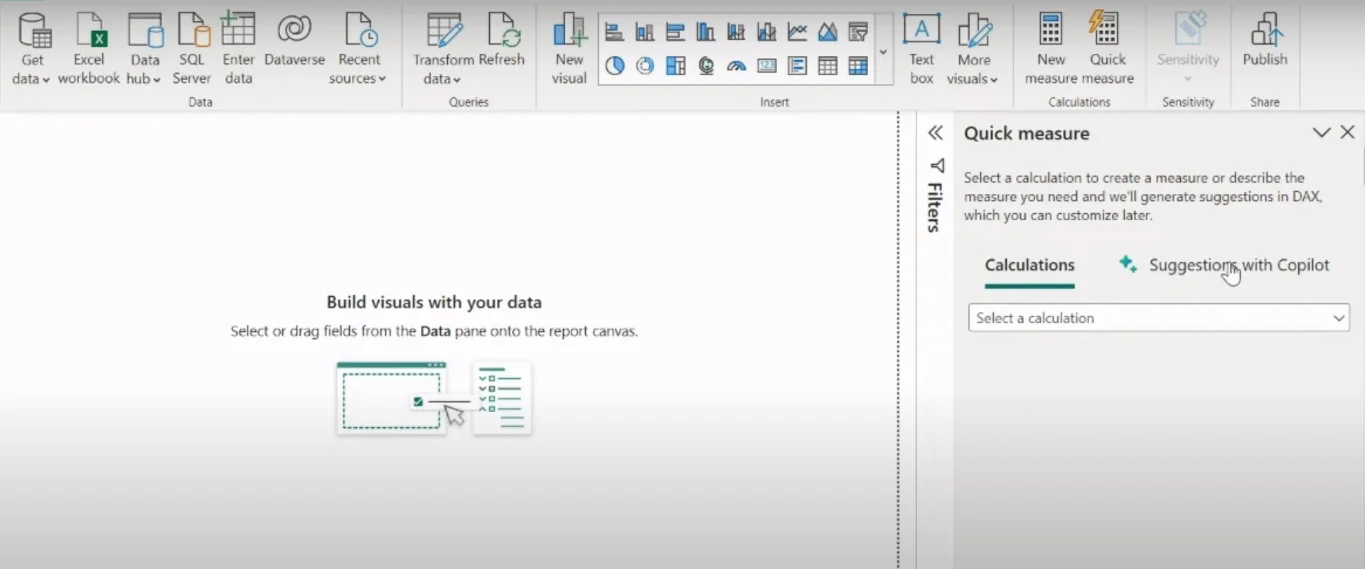
Microsoft Fabric Copilot’s AI-assisted support - Source: YouTube.
Machine learning and personalization
Permalink to “Machine learning and personalization”The machine learning abilities of Fabric Copilot help it understand and adapt to the unique needs and work styles of each user or company.
For example, it can be trained to recognize the particular terminology or project structures used in a company, allowing it to offer more precise and relevant help.
Plus, Fabric Copilot’s machine learning algorithms are capable of handling unstructured data, such as users’ queries in natural language. This means it can understand and respond to a variety of requests, regardless of how they’re phrased. Over time and with adequate training, the system can get better at understanding the subtle differences in human language, improving its ability to understand and respond to user queries.
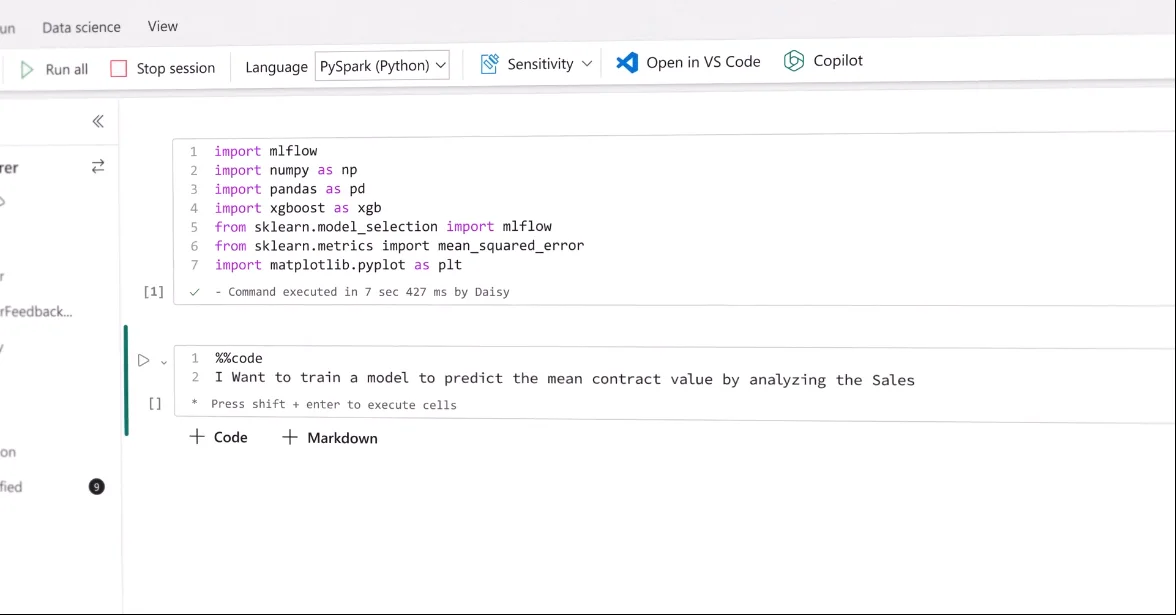
Fabric Copilot’s machine learning algorithms are capable of handling unstructured data - Source: Microsoft.
Copilot also learns from feedback. So, you can provide feedback on the system’s responses or actions, which it can then use to tweak its algorithms and perform better in the future. This feedback loop means Copilot keeps learning and improving, becoming more useful the more it’s used.
Understanding human language
Permalink to “Understanding human language”Fabric Copilot’s ability to understand natural language is a critical part of its AI capabilities. This technology allows the system to make sense of and interpret human language in a way that’s meaningful and relevant to the context.
For example, you can tell it to “Pull up the most recent sales data for our best-selling products,” and Copilot would understand that it needs to access sales data, identify the best-selling products based on that data, and fetch the latest figures for these products.
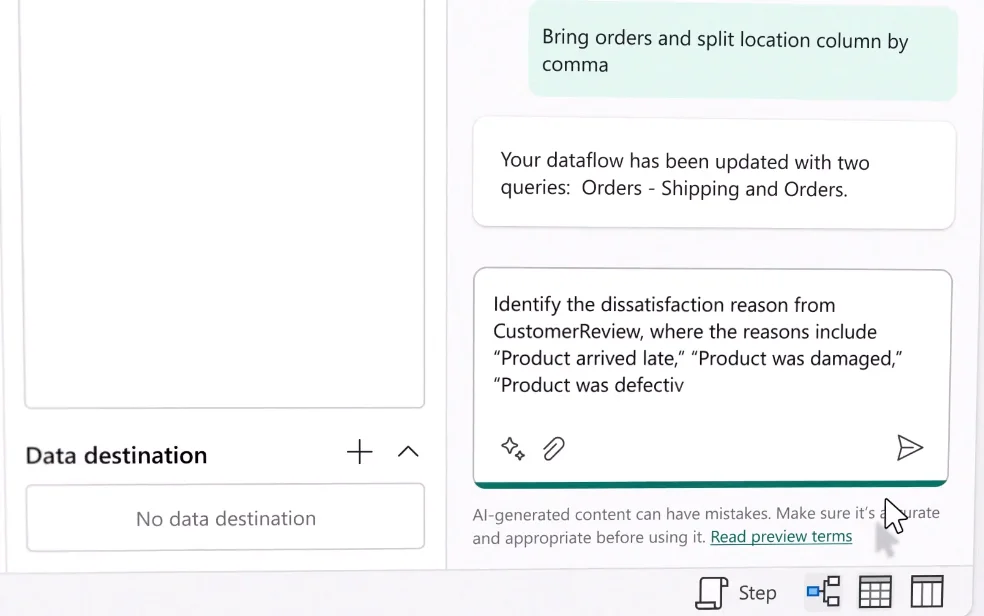
Microsoft Fabric Copilot’s understanding of human language - Source: Microsoft.
Furthermore, this understanding of natural language lets Fabric Copilot handle complex and multi-part queries.
For instance, you can ask it to “Set up a meeting with the marketing team next week to talk about the Q3 campaign and send out an agenda for the meeting beforehand.”
The system would understand that this involves several steps:
- Scheduling a meeting
- Identifying the relevant team members
- Setting a topic for the meeting
- Sending out an agenda
Copilot in each Microsoft Fabric experience: What would that look like?
Permalink to “Copilot in each Microsoft Fabric experience: What would that look like?”Let’s explore how Copilot works in each experience that Fabric currently offers:
Data Factory and Copilot
Permalink to “Data Factory and Copilot”In Data Factory, Copilot assists software engineers in creating complex data pipelines using natural language.
Engineers can describe the tasks they want to accomplish, such as copying data from SQL to a container in blob storage (i.e., a scalable and straightforward storage solution for storing vast quantities of unstructured data like files and images). Copilot would suggest and generate the necessary pipeline activities to achieve those tasks.
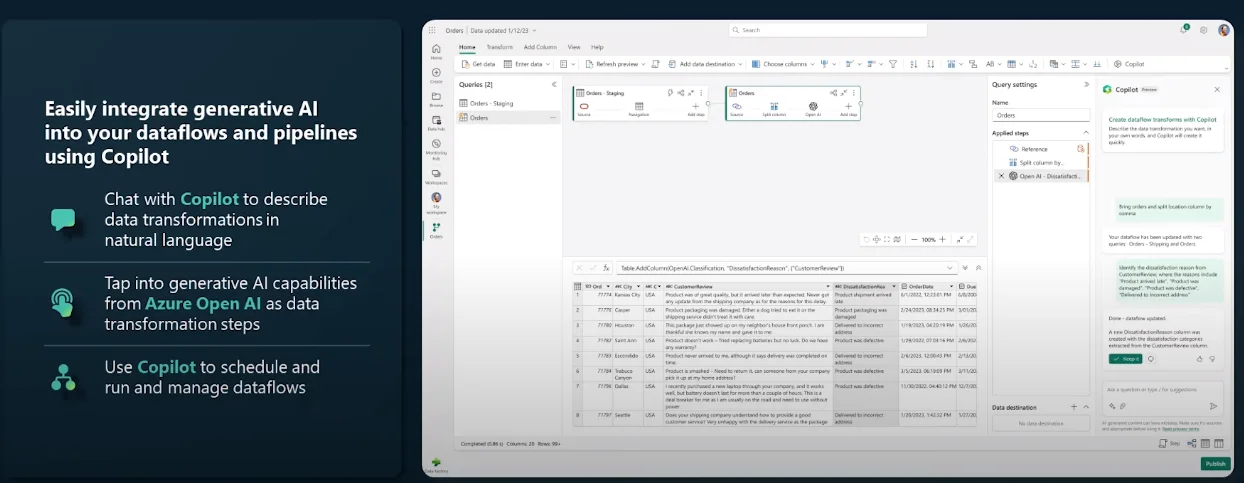
Copilot in Data Factory - Source: YouTube.
Synapse Data Science and Data Engineering and Copilot
Permalink to “Synapse Data Science and Data Engineering and Copilot”Copilot in data engineering workloads can help software engineers explore and analyze data. By describing their data exploration needs in natural language, Copilot generates code and executes queries accordingly.
For instance, data engineers might engage Copilot to delve into user behavior data from an application. They might express their need in simple terms like, “Gather data on user login frequency over the past six months, segmented by geographical region.”
Responding to this, Copilot would generate the appropriate code to extract, transform, and load the requested information from the application’s databases.
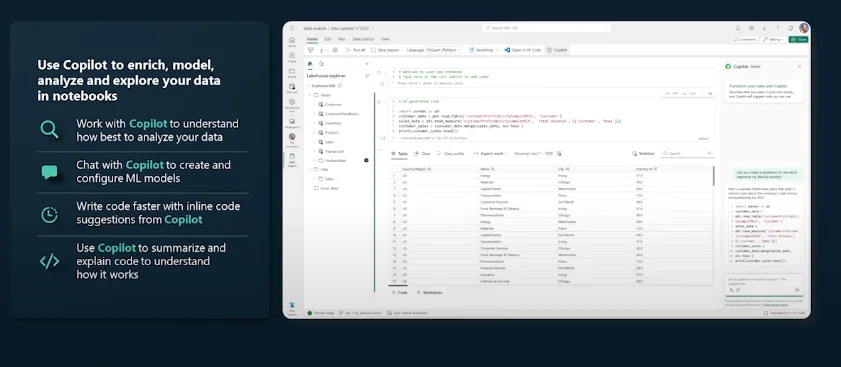
Copilot in Synapse Data Science and Data Engineering - Source: YouTube.
Microsoft Fabric Copilot for Data Science and Data Engineering has been adopted by over 100,000 organizations globally, reflecting its rapid integration into business operations. The AI-driven analytics feature is the most utilized, with 75% of users leveraging it for data insights and predictive modeling.
Synapse Analytics (Data Warehousing) and Copilot
Permalink to “Synapse Analytics (Data Warehousing) and Copilot”In Synapse Analytics, Copilot can assist data analysts with SQL queries and calculations by understanding their analysis requirements in plain language.
Analysts can describe the insights they need, such as finding top customers by sales over a specific time period, and Copilot would generate the SQL query to retrieve that information.
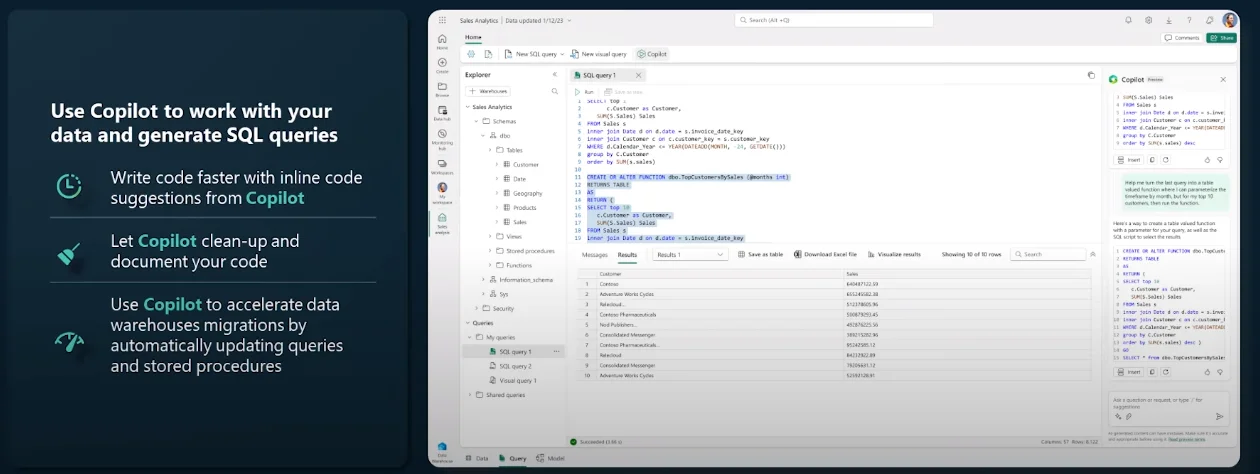
Copilot in Synapse Analytics - Source: YouTube.
Data Activator and Copilot
Permalink to “Data Activator and Copilot”Copilot in Data Activator can help software engineers set up triggers and monitor data changes.
Engineers can describe the conditions that should trigger actions, like sending an email when a certain temperature threshold is crossed, and Copilot would create the necessary rules and triggers.
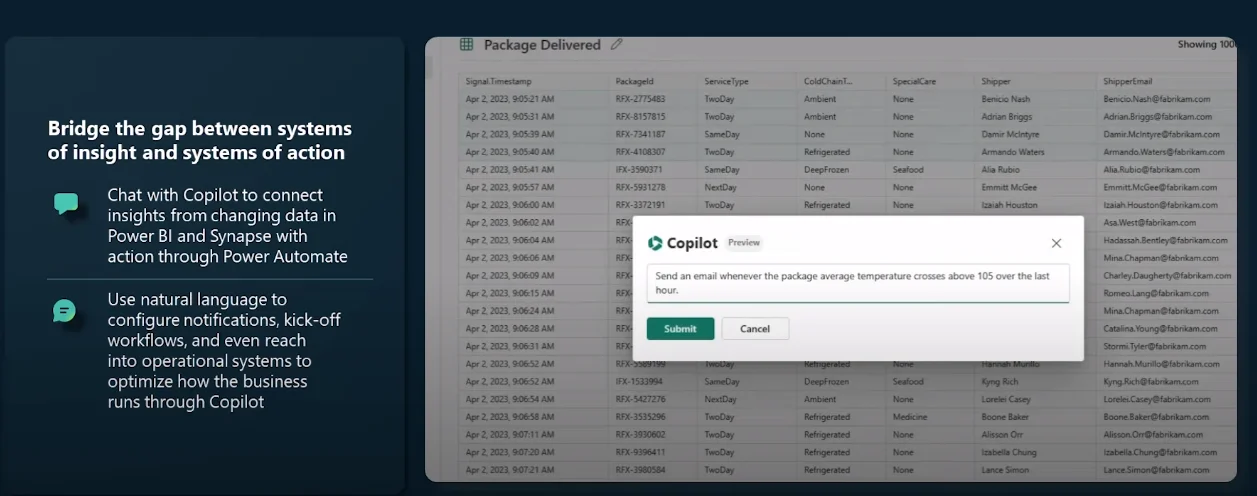
Copilot in Data Activator - Source: YouTube.
Power BI and Copilot
Permalink to “Power BI and Copilot”Copilot in Power BI enables business managers to create reports and gain insights using natural language descriptions. They can describe the visuals, insights, and calculations required, and Copilot would automatically generate the report, analyze data, and provide interactive visualizations.
For example, an HR manager can ask Copilot to create a report that breaks down employee data to understand demographics and hiring trends, and Copilot will generate the report with the requested charts and filters.
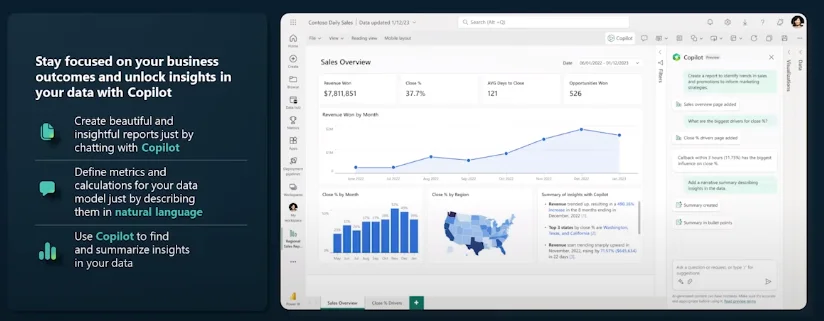
Copilot in Power BI - Source: YouTube.
Copilot in Microsoft Fabric: Real-world applications
Permalink to “Copilot in Microsoft Fabric: Real-world applications”Combining the power of Microsoft Fabric and Copilot opens up a world of real-world applications across various industries, such as:
- Marketing
- Supply chains
- Healthcare
- Finance
- Retail
Let’s explore each application further.
Marketing powered by data
Permalink to “Marketing powered by data”Marketing teams often juggle lots of data spread across different platforms. Microsoft Fabric simplifies this by offering a single platform to collect customer data from various sources, spot patterns, and target customers with customized marketing tactics.
At the same time, Microsoft Copilot can facilitate data analysis by creating automatic summaries, helping marketers understand data quickly and efficiently.
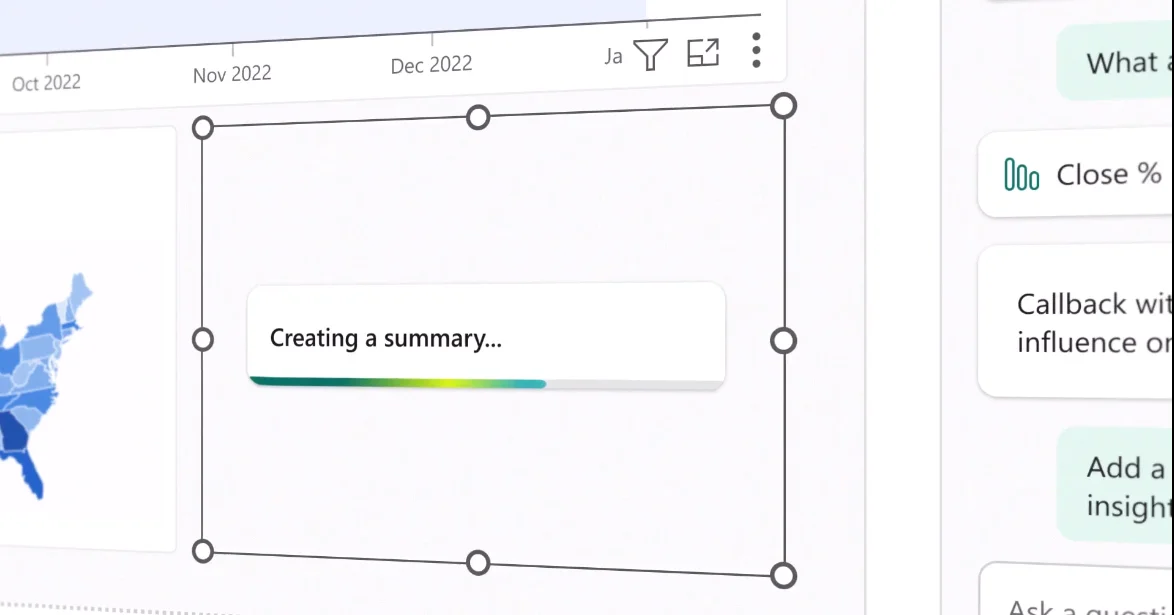
Creating summaries in Microsoft Fabric Copilot - Source: Microsoft.
Improving supply chains
Permalink to “Improving supply chains”Microsoft Fabric can help companies collect and combine supply chain data to get a clearer picture of how their supply chain is doing and where improvements can be made. Live analytics can be used to track shipments in real time and keep an eye on inventory levels.
Meanwhile, Copilot can make it easy for users to ask questions about the data and understand complex supply chain dynamics. For example, a user could ask, “How long does it usually take for a shipment to go from point A to point B?”
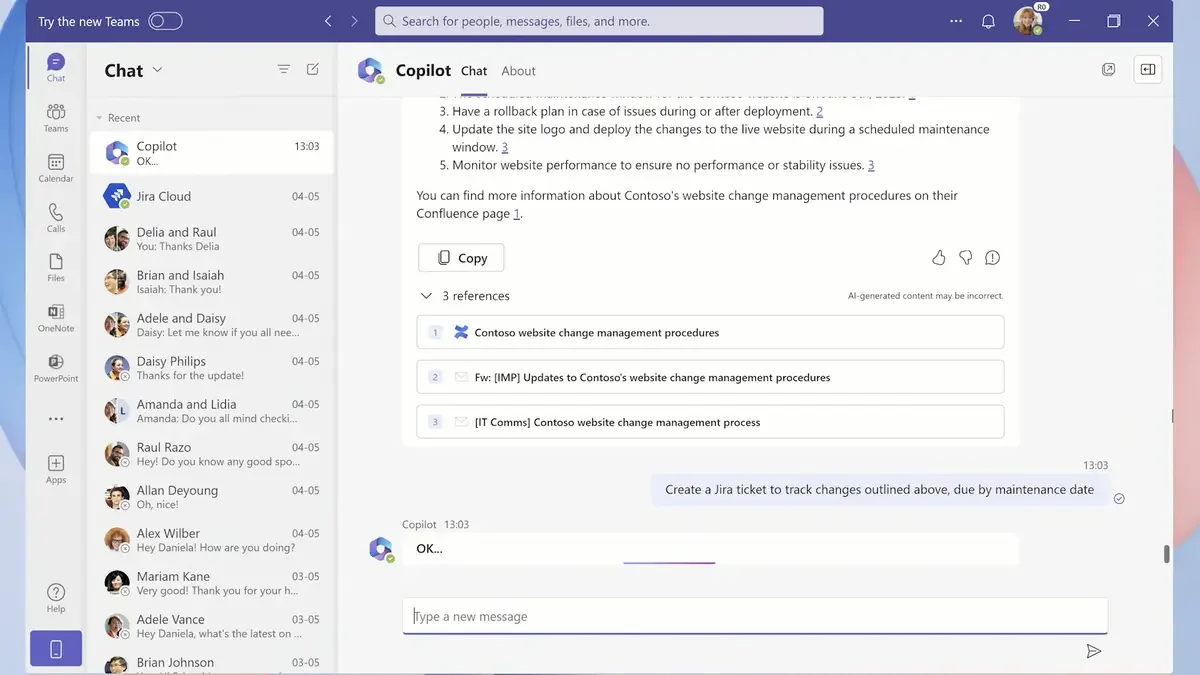
Creating Jira tickets through Microsoft Fabric Copilot to track supply chain process activities and issues - Source: Microsoft.
Managing healthcare data
Permalink to “Managing healthcare data”The healthcare sector generates a lot of data from various sources like electronic health records, imaging systems, and genomics research. Microsoft Fabric can help consolidate this data.
Copilot can help healthcare professionals interact with this data intuitively, answering questions like, “How many patients were diagnosed with condition X in the past year?”
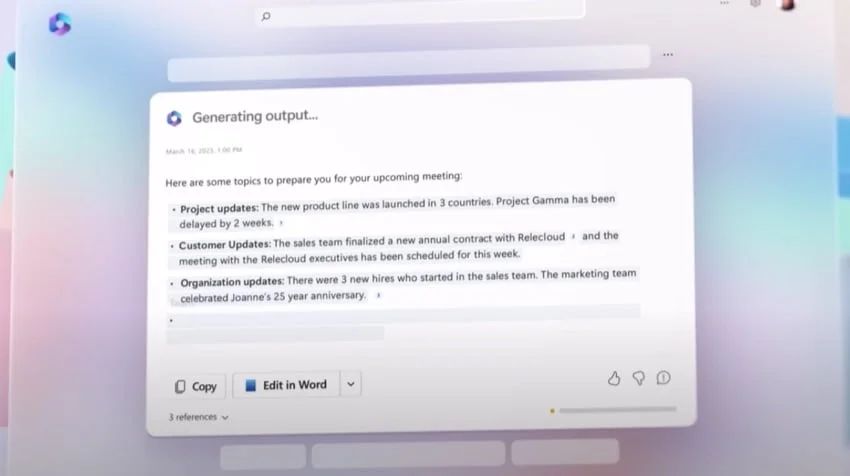
Microsoft copilot interacting with data consolidated in Microsoft Fabric - Source: Microsoft.
So, healthcare providers can use Microsoft Fabric and Copilot to predict patient outcomes, fine-tune treatments, and improve operations.
Generating financial insights
Permalink to “Generating financial insights”Microsoft Fabric can help manage and analyze real-time and historical financial data for various purposes such as risk assessment, making investment decisions, and ensuring regulatory compliance.
On the other hand, Copilot can help users quickly generate insights by providing the ability to ask questions about the data and create visuals and Data Analysis Expression (DAX) measures (i.e., special calculations that you can create in Power BI, Power Pivot, and Analysis Services Tabular models).
For example, a user could ask, ”What were the revenue trends over the past five years?”
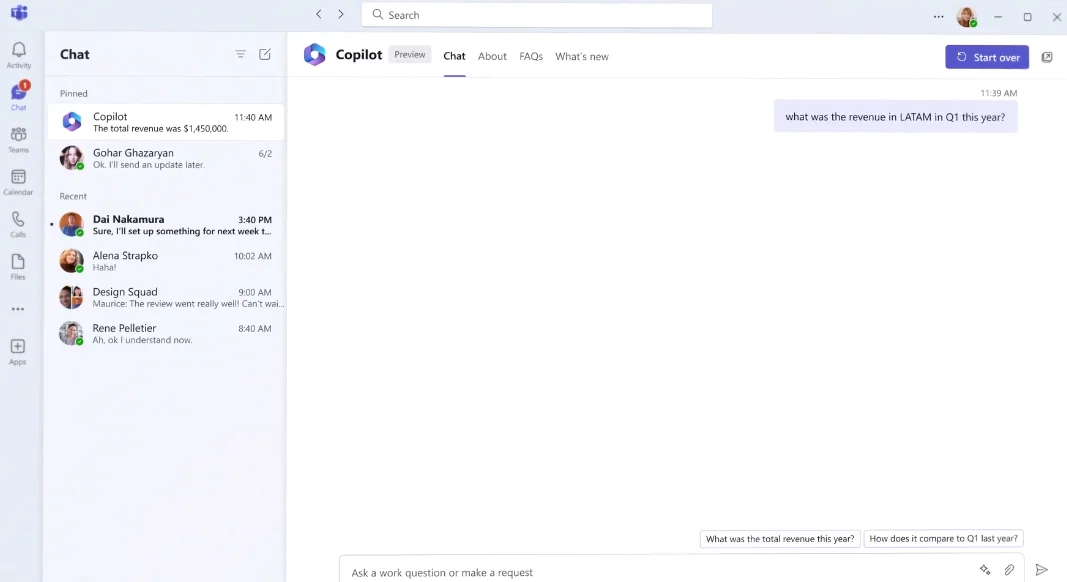
Copilot providing financial insights about data in Microsoft Fabric - Source: Microsoft.
Retail analytics
Permalink to “Retail analytics”In the retail sector, Microsoft Fabric can be used to collect data about customer preferences, sales, and inventory from different sources. This data can be used to personalize the shopping experience, fine-tune inventory management, and boost sales.
Copilot can support this process by making data analysis more user-friendly and intuitive, creating summaries of sales data, and allowing users to ask questions about the data. For instance, “What were our top-selling products last quarter?”
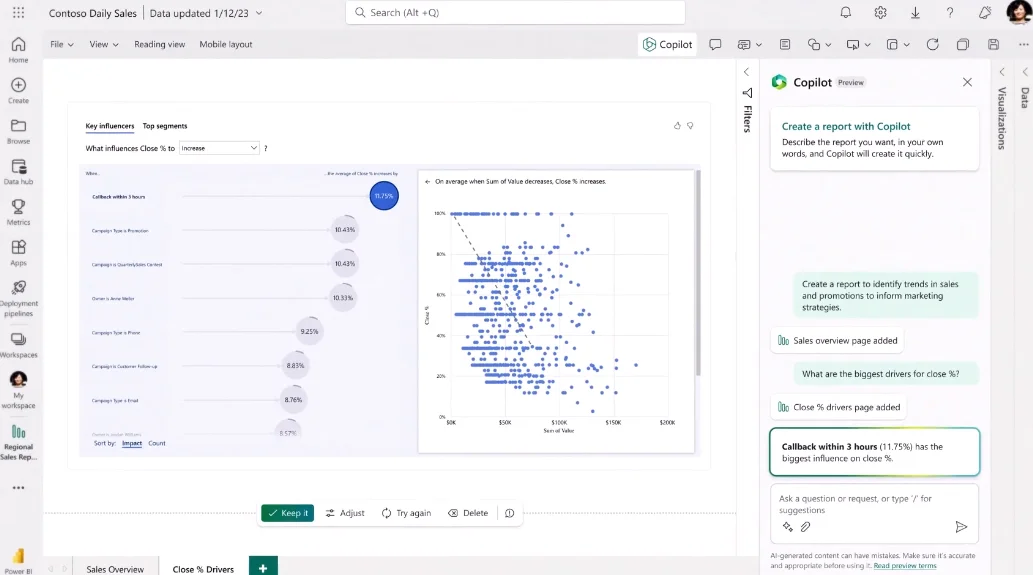
Creating sales data reports in Microsoft Fabric - Source: Microsoft.
Also, read → How Microsoft Copilot will transform manufacturing | How Microsoft Fabric Cut Cloud Costs by 50% for Global Firm
Copilot in Microsoft Fabric: Limitations
Permalink to “Copilot in Microsoft Fabric: Limitations”While Microsoft Copilot offers significant benefits in automating tasks and simplifying workflows, it’s important to acknowledge some limitations and challenges users might face when integrating it into their operations.
These include:
- Limited support for connectors
- Inability to resolve flow errors
- Limited support for parametrization
- Limited looping functions
Let’s delve into the specifics.
Limited support for connectors
Permalink to “Limited support for connectors”Connectors in Microsoft Fabric are the links that allow various services to talk to each other.
Copilot doesn’t support all connectors, which means it may not allow all services to interact seamlessly. This limitation can prevent users from automating data transfer or actions between some services, limiting the effectiveness of Copilot in some scenarios.
Therefore, users need to check if the connectors they need are compatible with Copilot.
Unable to resolve flow errors
Permalink to “Unable to resolve flow errors”When setting up a flow (which is a sequence of steps that your data takes), you might encounter issues due to various reasons like improperly configured steps, wrong inputs, or connection problems.
Copilot doesn’t have the ability to troubleshoot and fix these errors, which could be a challenge, especially for users depending on it to handle the complexities of setting up flows. As such, users need some level of knowledge about the system to manually identify and fix any issues that come up.
Limited support for parameterization
Permalink to “Limited support for parameterization”Parameters are the inputs that the actions within a flow need to carry out their tasks.
If Copilot can’t fully support parameterization (as in its preview phase), it might not be able to automatically provide these inputs for all actions.
This could make the automation process slower, as users might have to manually input parameters for some actions.
Limited looping functions
Permalink to “Limited looping functions”Looping constructs like “Apply to each” and “Do until” are essential for carrying out repetitive tasks within a flow.
As Copilot has limited support for these constructs in the preview phase, it might not be able to fully automate repetitive actions, which would force users to manually include these constructs in their flows.
This limitation could impact the efficiency and the extent of automation that Copilot can provide.
Copilot for workflow automation via Microsoft Fabric (Power BI) and Power Automate: A step-by-step guide
Permalink to “Copilot for workflow automation via Microsoft Fabric (Power BI) and Power Automate: A step-by-step guide”Power BI, which is a part of Microsoft Fabric, has been designed to either send or receive data for Power Automate workflows (or flows).
So, the data you visualize and analyze in Power BI can trigger automated tasks in Power Automate, and the outcomes of those tasks can be fed back into Power BI for additional analysis and reporting.
This setup simplifies the automation of data-driven processes, with:
- Fabric serves as the unified data platform
- Power BI (and Copilot) for data analysis and visualization
- Power Automate (and Copilot) for automating tasks
Here’s a simple guide to start using it:
- Login to Power Automate.
- Begin by explaining what you want to automate. Based on what you type, Copilot will provide some flow suggestions.
- Pick one of the suggestions or stick with the one you’ve created.
- If you’re happy with the flow created by Copilot, click “Next.” You can change your prompt for other suggestions.
- Check the apps and services you’ve connected, then click “Next.”
- Wrap up your flow by adjusting the required settings, then click “Create flow.”
- Follow Copilot’s advice to finalize the flow setup, or use Copilot to make changes to your flow.
- Remember to save your flow once it’s done.
- It’s a good practice to try out your flow after saving it; you can do that by clicking “Test” in the top-right corner.
You can also edit your existing flows with the help of Copilot:
- Login to Power Automate.
- Click “My flows” on the left sidebar.
- Find the flow you want to edit, then click on the three vertical dots (⋮).
- Click on “Edit > Try AI-powered editing (preview).” Your flow will open in the Copilot editing mode and you can start editing your flow using Copilot.
Copilot in Microsoft Fabric: Tips
Permalink to “Copilot in Microsoft Fabric: Tips”When you’re asking something from Copilot, it’s recommended to:
- Format your requests like “When X happens, do Y.”
- Be as detailed as you can in your request.
- If possible, include the connector in your request, like Outlook, Teams, Forms, etc.
- Modify your request to get better results if the initial ones aren’t up to the mark.
Also, read → Learn to Use Copilot in Microsoft Fabric | Microsoft Fabric and Copilot in Microsoft Power BI | Does scaling the Fabric Capacity cause any issues for Copilot?
How organizations making the most out of their data using Atlan
Permalink to “How organizations making the most out of their data using Atlan”The recently published Forrester Wave report compared all the major enterprise data catalogs and positioned Atlan as the market leader ahead of all others. The comparison was based on 24 different aspects of cataloging, broadly across the following three criteria:
- Automatic cataloging of the entire technology, data, and AI ecosystem
- Enabling the data ecosystem AI and automation first
- Prioritizing data democratization and self-service
These criteria made Atlan the ideal choice for a major audio content platform, where the data ecosystem was centered around Snowflake. The platform sought a “one-stop shop for governance and discovery,” and Atlan played a crucial role in ensuring their data was “understandable, reliable, high-quality, and discoverable.”
For another organization, Aliaxis, which also uses Snowflake as their core data platform, Atlan served as “a bridge” between various tools and technologies across the data ecosystem. With its organization-wide business glossary, Atlan became the go-to platform for finding, accessing, and using data. It also significantly reduced the time spent by data engineers and analysts on pipeline debugging and troubleshooting.
A key goal of Atlan is to help organizations maximize the use of their data for AI use cases. As generative AI capabilities have advanced in recent years, organizations can now do more with both structured and unstructured data—provided it is discoverable and trustworthy, or in other words, AI-ready.
Tide’s Story of GDPR Compliance: Embedding Privacy into Automated Processes
Permalink to “Tide’s Story of GDPR Compliance: Embedding Privacy into Automated Processes”- Tide, a UK-based digital bank with nearly 500,000 small business customers, sought to improve their compliance with GDPR’s Right to Erasure, commonly known as the “Right to be forgotten”.
- After adopting Atlan as their metadata platform, Tide’s data and legal teams collaborated to define personally identifiable information in order to propagate those definitions and tags across their data estate.
- Tide used Atlan Playbooks (rule-based bulk automations) to automatically identify, tag, and secure personal data, turning a 50-day manual process into mere hours of work.
Book your personalized demo today to find out how Atlan can help your organization in establishing and scaling data governance programs.
Summary
Permalink to “Summary”Microsoft Fabric and Copilot provide data practitioners with powerful tools to address data management challenges and unlock the full potential of data.
Fabric offers a unified platform for data gathering, combining, and analysis, while Copilot enhances data analysis with AI-guided insights.
By leveraging both solutions, businesses can overcome data silos, integration costs, poor data quality, and outdated reports. Real-world applications in marketing, supply chain management, healthcare, finance, and retail analytics demonstrate the tangible benefits of this combination.
Research on Generative AI by Avanade suggests that 92% of manufacturers aim to be AI-first within a year. This is an ambitious target given that just 7% currently use AI on an hourly basis to inform their real-time operations.
However, it is important to be aware of the limitations of Copilot — limited support for connectors, inability to resolve flow errors, and restrictions on parameterization and looping functions.
FAQs about Microsoft Fabric Copilot
Permalink to “FAQs about Microsoft Fabric Copilot”1. What is Microsoft Fabric Copilot?
Permalink to “1. What is Microsoft Fabric Copilot?”Microsoft Fabric Copilot is an AI-powered assistant integrated into Microsoft Fabric. It leverages natural language processing to help users generate reports, automate tasks, and streamline data workflows, making data analytics accessible to both technical and non-technical users.
2. How does Fabric Copilot assist in data integration?
Permalink to “2. How does Fabric Copilot assist in data integration?”Fabric Copilot simplifies data integration by automating the creation of data pipelines and workflows. Users can describe their integration needs in natural language, and Copilot generates the necessary steps to combine data from various sources.
3. What are the benefits of using AI in Microsoft Fabric?
Permalink to “3. What are the benefits of using AI in Microsoft Fabric?”AI in Microsoft Fabric enhances data analysis by providing intelligent recommendations, automating repetitive tasks, and enabling users to interact with data using natural language. This reduces the time required to generate insights and improves overall decision-making.
4. How can Copilot streamline analytics workflows?
Permalink to “4. How can Copilot streamline analytics workflows?”Copilot in Microsoft Fabric streamlines analytics by automating the generation of SQL queries, creating visual reports, and setting up triggers for real-time data monitoring. Users can request specific insights, and Copilot delivers actionable data quickly.
5. Is Microsoft Fabric Copilot secure?
Permalink to “5. Is Microsoft Fabric Copilot secure?”Yes, Microsoft Fabric Copilot is built on the Azure OpenAI architecture, which includes robust security measures. It ensures data privacy and compliance with industry standards, protecting sensitive business information.
6. Can Fabric Copilot optimize business decisions?
Permalink to “6. Can Fabric Copilot optimize business decisions?”By providing accurate, real-time insights and automating data analysis tasks, Fabric Copilot enables businesses to make informed decisions. It identifies trends and patterns, helping organizations respond proactively to market changes.
Microsoft Fabric Copilot: Related reads
Permalink to “Microsoft Fabric Copilot: Related reads”- Microsoft Fabric: A Comprehensive Overview of Microsoft’s New Data Platform
- 7 Microsoft Fabric Use Cases in Data and Analytics
- Microsoft Fabric vs. Power BI: Architecture, Capabilities, Data Governance, and Use Cases
- Microsoft Fabric vs. Azure Synapse Analytics: Architecture, Features, Migration Possibilities, FAQs
Share this article




















